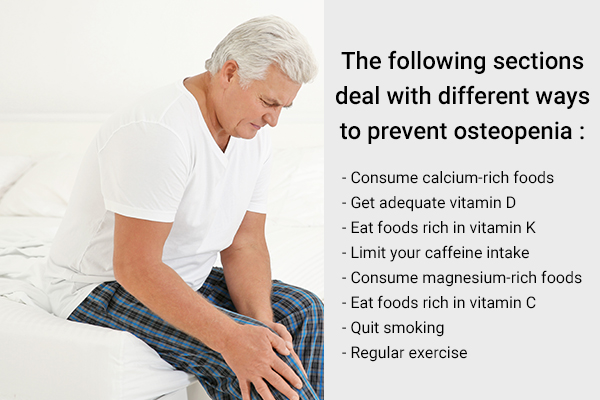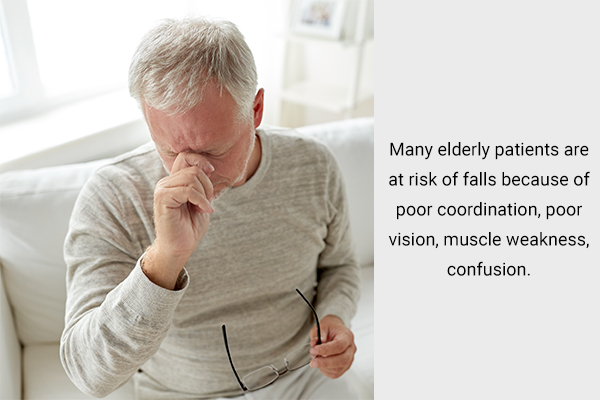In this article:
The bones in your body are made up of calcium and phosphate minerals, which form the matrix. Into this matrix, different proteins, such as collagen, are deposited to give you the final bone. (1)

With age, the composition of the bone changes, and the rate of breakdown of bone tissue exceeds its rate of formation. These changes, in turn, result in loss of minerals from the bone, leading to low bone mineral density (BMD), a condition referred to as osteopenia.
Osteopenia is different from osteoporosis, in that in the latter condition, the bones become thinner, more fragile, and brittle. However, osteopenia can lead to osteoporosis if left unchecked.
Osteopenia may also occur due to low bone mass. (2) Osteoporosis and osteomalacia are two metabolic conditions that can cause reduced bone mass. Osteoporosis does not change the bone mineral to bone matrix ratio, but osteomalacia can lower it.
Osteoporosis occurs more commonly in the United States, but both disorders can coexist in a person. (3) It is important to understand the risk factors that contribute to low bone mineral density. Continue reading to learn what causes low bone mineral density and how to prevent it. (2)
How to Prevent Loss of Bone Mineral Density
If you think that you are at risk of having a low bone mineral density, you can make dietary and lifestyle changes to arrest osteopenia and prevent osteoporosis. The following sections deal with different ways to prevent osteopenia.
1. Consume calcium-rich foods
Bones are mainly made of calcium, and hence, consumption of adequate amounts of calcium is needed to maintain a good bone mineral density.
A 2020 study conducted on female mice has shown that calcium supplementation suppressed osteopenia in mice whose bone density was low due to the administration of the drug rabeprazole. (4)
Foods rich in calcium include dairy products, green vegetables such as broccoli, soy products such as tofu, and dried fruits.
2. Get adequate vitamin D
Vitamin D is essential for bone mineralization – that is, for the deposition of adequate amounts of calcium in the bones. Hence, ensure that you get the recommended daily allowance (2,000 IU for adults) of vitamin D. This is possible by maintaining a balanced diet.
Foods rich in vitamin D are eggs, salmons, and sardines. Moreover, many fruit juices are fortified with vitamin D. Additionally, exposure to sunlight causes the body to produce vitamin D. Thus, expose yourself to sunlight for at least 15 minutes daily.
Vitamin D supplementation is only recommended in patients with a high risk of calcium and vitamin D insufficiency and not otherwise. (5)
3. Eat foods rich in vitamin K
Vitamin K promotes bone health by increasing bone mineral density (6) and reducing the risk of fractures. You can increase your vitamin K intake by consuming foods rich in it, such as fermented dairy products, broccoli, and prunes.

4. Limit your caffeine intake
Although caffeine intake is associated with some health benefits, excessive consumption can be harmful to bone health.
A high intake of caffeine increases calcium excretion by the kidneys, thus lowering bone mineral density, as reported in a 2021 study published in the British Journal of Clinical Pharmacology. (7)
5. Boost up your consumption of potassium-rich foods
A positive link between potassium intake and bone mineral density has been reported in a 2020 Korean study reported in Nutrition Research and Practice, (8) suggesting that the consumption of foods rich in potassium can prevent osteopenia and osteoporosis.
Bananas, avocados, strawberries, mangoes, oranges, kiwis, apricots, dates, broccoli, dates, and carrots are potassium-rich foods.
6. Consume magnesium-rich foods
Magnesium affects bone health by increasing bone mineral density and reducing the risk of fractures associated with osteoporosis.
A 2019 study that included urban South African women has reported that magnesium intake improves bone health. (9)
Moreover, a review paper published in 2021 has cited many studies that highlighted the importance of magnesium intake in improving bone health and reducing fracture risk. (10)
Foods rich in magnesium are nuts such as walnuts, almonds, cashews, and pecan nuts, pumpkin seeds, yogurt, tofu, bananas, avocados, beans, green leafy vegetables, and cereals.
Consult your doctor before taking magnesium supplements.
7. Maintain a moderate intake of sodium
A diet high in sodium (salt) causes increased excretion of calcium through the kidneys, and this could lead to low bone mineral density. (11)
However, a recent report in 2022 argues that low sodium intake may lead to decreased bone mineral density by altering the hormonal balance. (12) Hence, moderation in salt intake is the key to good bone health.
8. Eat foods rich in vitamin C
A diet rich in vitamin C-containing foods increases bone mineral density and decreases fracture risk, as reported in a meta-analysis conducted in 2020. (13)
In this study, the positive effect of vitamin C-rich foods on bone mineral density was attributed to the presence of not only vitamin C but also antioxidants, vitamin K, and phytochemicals in vitamin C-rich foods.
Foods abundant in vitamin C are oranges, lemons, strawberries, pineapple, kiwi, cauliflower, broccoli, and bell peppers.
9. Quit smoking
Cigarette smoking is associated with significant bone loss, which can lead to osteopenia and osteoporosis.
A 2020 review published in Genes has summarized the genetic alterations induced by smoking, which can lead to low bone mineral density. (14)
Since cigarette smoking is addictive, quitting smoking could improve bone mineral density and prevent osteopenia.
10. Exercise regularly
A sedentary lifestyle increases the risk of osteopenia and osteoporosis. Brisk walking, hiking, and dancing are recommended for improving bone health.
A 2019 study conducted on postmenopausal women and reported in Medicine stated that aerobic dance is safe, effective, and efficient in improving bone mineral density. (15)
There is no ideal exercise time stipulated by doctors for the maintenance of bone health since this depends on a lot of factors such as personal stamina and coexisting medical conditions. However, exercising for half an hour every day can be beneficial for most people.
You can consult a physical therapist for a proper exercise routine.
Risk Factors of Low Bone Mineral Density
Bone mineral density can decline as a result of the following:
- Diet: A diet low in calcium and vitamin D can predispose you to developing low bone mineral density. Smoking and drinking heavily are other risk factors.
- Age: Osteopenia affects people aged over 50 years. Women are more prone to developing the condition than men, on account of low estrogen levels at that age.
- Some medications: Certain medications taken over long periods accelerate bone loss. Examples of such drugs are steroids, seizure medications, and cancer drugs. (16)
- Certain medical conditions: Hyperthyroidism, hyperparathyroidism, menopause, diabetes, and rheumatoid arthritis are some of the medical conditions that can lead to osteopenia. (2)
Additional Tips by Experts

Here are a few tips you can follow to improve bone health:
- Lose excess body weight and try to maintain your weight within the normal BMI range.
- Reduce caffeine and alcohol intake.
- Try to consume at least 1,000 mg of calcium every day. Older women (postmenopause) should try to consume 1,200-1,500 mg of calcium every day. You can consult your doctor for a calcium supplement if needed. (17)
- Estrogen can help reduce bone density loss and prevent weakness in the bones. Most doctors recommend taking 0.625 to 1.25 mg of estrogen per day from the 4th or 5th year of menopause in older women. (18)
- Bisphosphonates are medicines that can prevent bone loss and treat osteopenia. They prevent bone mineral resorption. Bisphosphonate treatment includes alendronate 10 mg given orally once a day, ibandronate 2.5 mg orally once a day, or risedronate 5 mg. (19)
- Taking precautions to reduce falls in elderly patients can lower the risk of fractures. This may include medications to improve coordination, hip pads, etc.
Most-Asked Questions About Osteopenia
Can osteopenia be reversed?
Bone loss is a natural part of the aging process and begins at the age of 30 in most men and women. However, osteopenia can be halted by adopting a healthy lifestyle such as exercising regularly, avoiding smoking, limiting caffeine intake, and taking a balanced diet.
What are the best exercises for improving bone mineral density?

Aerobic exercises, brisk walking, and elliptical biking are recommended for improving bone mineral density.
In addition, some yogic postures are recommended to treat osteopenia and osteoporosis. These are the cobra pose (Bhujangasana), which strengthens the arms and spine; the bridge pose (Sethubandasan), which strengthens the lower back and thighs; and the tree pose (Vrikshasan), which strengthens the legs and improves balance.
A word of caution, both aerobic exercises and yoga should be learned from a seasoned professional; otherwise; they could be counterproductive.
How is decreased bone mineral density screened and diagnosed?
Screening for osteopenia is done by:
- Dual-energy X-ray absorptiometry (DEXA) – This screening test is recommended especially for postmenopausal women.
- Bone mineral density tests for older women between 50-65 years of age.
Younger men and women with frequent fractures or other symptoms should also be screened for osteopenia.
Final Word
Bone loss starts in men and women after the age of 30. In women, the effects are seen earlier because of hormonal factors.
You can fight the process by using a combination of regular exercise, a balanced diet, and a healthy lifestyle.
- Was this article helpful?
- YES, THANKS!NOT REALLY


